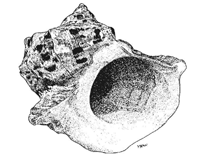Turbo marmoratus Linnaeus, 1758
Green turban| Native range | All suitable habitat | Point map | Year 2050 |

|
| This map was computer-generated and has not yet been reviewed. |
| Turbo marmoratus AquaMaps Data sources: GBIF OBIS |
Classification / Names Common names | Synonyms | CoL | ITIS | WoRMS
Gastropoda | Trochida | Turbinidae
Environment: milieu / climate zone / depth range / distribution range Ecology
Benthic; depth range 1 - 30 m (Ref. 349). Tropical; 31°N - 29°S, 79°E - 180°E
Distribution Countries | FAO areas | Ecosystems | Occurrences | Introductions
Indo-Pacific: from East Africa, to eastern Melanesia; north to southern Japan and south to northern Queensland and Fiji Islands. Successfully introduced in French Polynesia in the 1960s.
Length at first maturity / Size / Weight / Age
Maturity: Lm ? range ? - ? cm Max length : 22.0 cm SHL male/unsexed; (Ref. 349); common length : 18.0 cm SHL male/unsexed; (Ref. 349)
Extensively used for food, shell jewelry, inlay, and button making. It is the most important commercial species of Turbinidae in the tropical Indo-West Pacific. Intensive fishing for the mother-of-pearl trade has drastically reduced many turban populations in recent years. In order to protect existing resources and to increase the possibilities of long-term exploitations, attempts of juvenile production, reintroduction, translocation, and commercial legislation are under way in the area (Ref. 349). Maximum depth from Ref. 75835. In subtidal, coral reef areas open to a constant flow of clean oceanic water. Juveniles mainly living on reef crests; adults also occurring deeper on slopes to about 20 m or more (Ref. 349). Found at depths of 10 to 30 m, on rocks (Ref. 75835). Primarily herbivorous, with few small animals eaten that are associated with the assemblage of algae (Ref. 105749).
Life cycle and mating behavior Maturity | Reproduction | Spawning | Eggs | Fecundity | Larvae
Members of the order Patellogastropoda are mostly gonochoric and broadcast spawners. Life cycle: Embryos develop into planktonic trocophore larvae and later into juvenile veligers before becoming fully grown adults.
Main reference
References | Coordinator | Collaborators
Poutiers, J.M. 1998. (Ref. 349)
IUCN Red List Status
(Ref. 130435: Version 2024-2)
CITES status (Ref. 108899)
Not Evaluated
CMS (Ref. 116361)
Not Evaluated
Threat to humans
Harmless
Human uses
Fisheries: commercial
| FishSource |
Tools
More information
Trophic Ecology
Ecology
Population dynamics
Growth
Max. ages / sizes
Length-weight rel.
Length-length rel.
Length-frequencies
Mass conversion
Recruitment
Abundance
Max. ages / sizes
Length-weight rel.
Length-length rel.
Length-frequencies
Mass conversion
Recruitment
Abundance
Life cycle
Human Related
Aquaculture profiles
Stamps, coins, misc.
Stamps, coins, misc.
Outreach
Taxonomy
References
Internet sources
BHL | BOLD Systems | CISTI | DiscoverLife | FAO(Publication : search) | Fishipedia | GenBank (genome, nucleotide) | GloBI | Gomexsi | Google Books | Google Scholar | Google | PubMed | Tree of Life | Wikipedia (Go, Search) | Zoological Record
Estimates based on models
Preferred temperature
(Ref. 115969): 25.7 - 29.3, mean 28.7 (based on 2558 cells).



